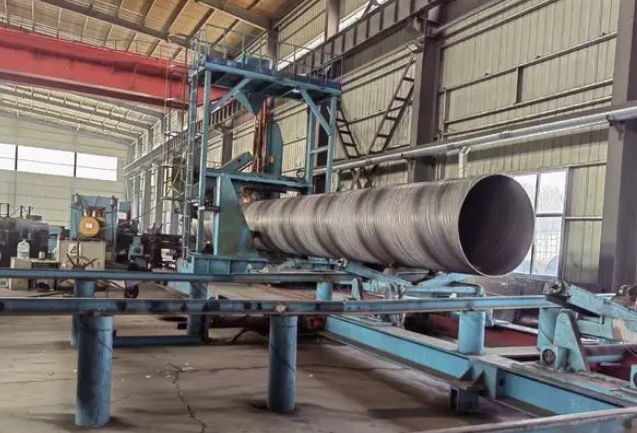The spiral welded pipe (SSAW) forming process is a mature and efficient steel pipe manufacturing technology, which is widely used in oil, natural gas, water and other fields. This article will introduce in detail the principles, advantages, processes and influencing factors of the spiral welded pipe forming process to help everyone gain an in-depth understanding of this manufacturing process.
Spiral welded pipe forming process principle:
The spiral welded pipe forming process uses strip steel coils as raw materials, and the strip steel coils are deformed into spiral-shaped tube blanks through a continuous spiral former. During the forming process, the shape and size of the tube blank are maintained stable by controlling the rotation speed, friction and other parameters of the former.

Advantages of spiral welded pipe forming process:
1. Efficiency: The spiral welded pipe forming process adopts a continuous production line, which has high production efficiency and can meet the needs of large-scale production.
2. Cost saving: Compared with the traditional straight seam welded pipe production process, the spiral welded pipe forming process consumes less raw materials and has lower production costs.
3. Excellent forming quality: By accurately controlling forming parameters, the spiral welded pipe forming process can ensure the shape and size accuracy of the tube blank and improve product quality.
4. Wide applicability: The spiral welded pipe forming process is suitable for strip coils of different materials, thicknesses and diameters, and has a wide range of applications.
Spiral welded pipe forming process:
1. Pre-treatment of steel strip coils: Pre-processing of steel strip coils such as leveling and shearing is carried out to ensure the quality of raw materials.
2. Continuous spiral forming: The strip coil is fed into the continuous spiral former, and a spiral-shaped tube blank is formed through multiple passes of deformation.
3. Welding: Use welding equipment to fix the spiral shape of the tube blank to form a continuous spiral welded tube.
4. Finishing: Perform straightening, flaw detection and other finishing treatments on the welded spiral welded pipes to ensure that the products meet quality requirements.
5. Storage and transportation: Store the finished spiral welded pipe and transport it to the destination as needed.
Factors affecting the forming quality of spiral welded pipes:
1. Forming parameters: including the rotation speed, friction and other parameters of the former, which directly affect the shape and dimensional accuracy of the tube blank.
2. Strip coil quality: The material, thickness, surface quality and other factors of the strip coil will affect the forming effect, and the quality of raw materials needs to be strictly controlled.
Tips: Welded steel pipes can be divided into three types: straight seam submerged arc welded steel pipes, spiral welded steel pipes, and high-frequency straight seam welded steel pipes (Electric Resistance Welded Steel Pipe) according to the forming method of the weld seam.


